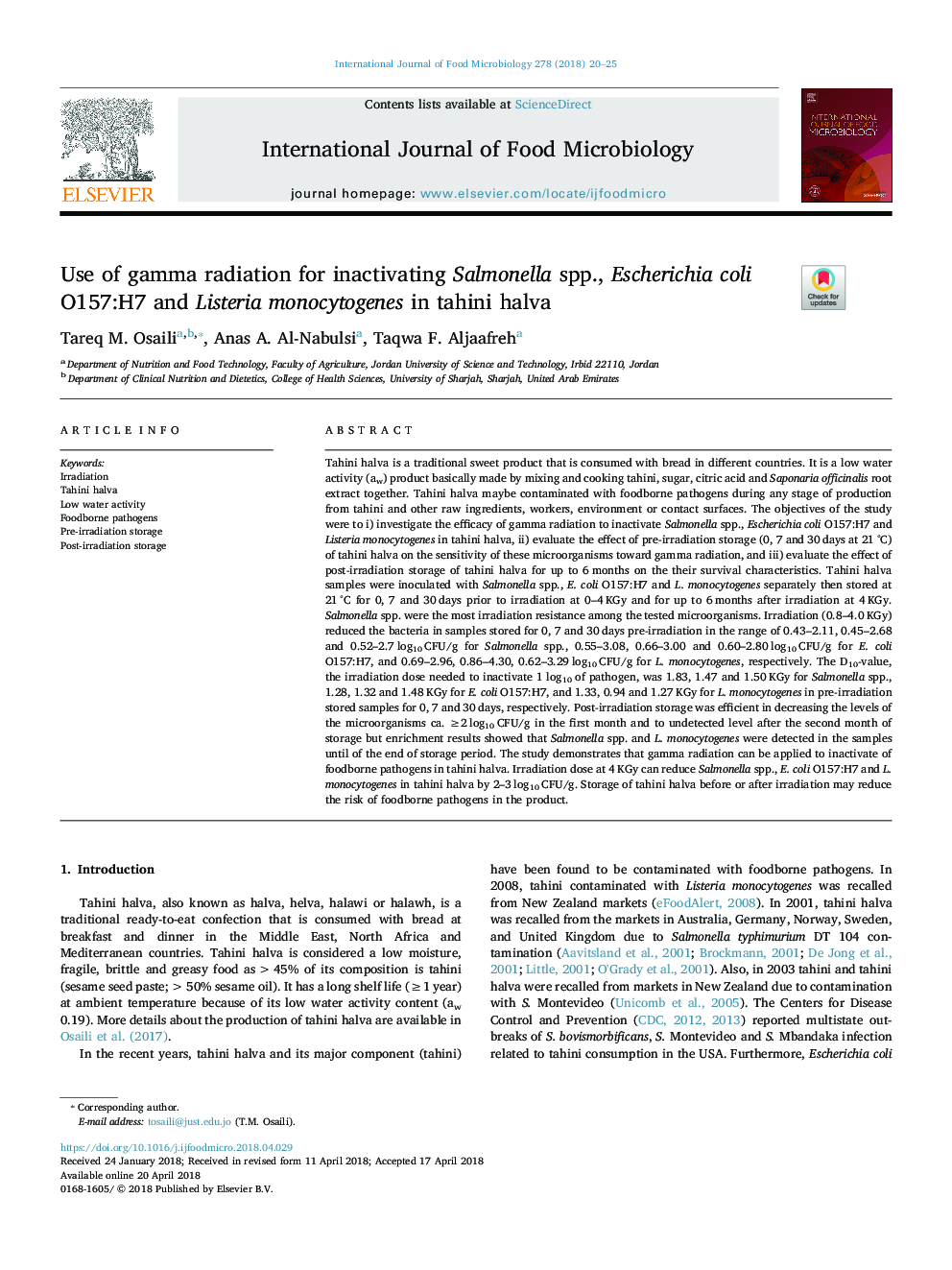| کد مقاله | کد نشریه | سال انتشار | مقاله انگلیسی | نسخه تمام متن |
|---|---|---|---|---|
| 8844163 | 1616505 | 2018 | 6 صفحه PDF | دانلود رایگان |
عنوان انگلیسی مقاله ISI
Use of gamma radiation for inactivating Salmonella spp., Escherichia coli O157:H7 and Listeria monocytogenes in tahini halva
دانلود مقاله + سفارش ترجمه
دانلود مقاله ISI انگلیسی
رایگان برای ایرانیان
کلمات کلیدی
موضوعات مرتبط
علوم زیستی و بیوفناوری
علوم کشاورزی و بیولوژیک
دانش تغذیه
پیش نمایش صفحه اول مقاله

چکیده انگلیسی
Tahini halva is a traditional sweet product that is consumed with bread in different countries. It is a low water activity (aw) product basically made by mixing and cooking tahini, sugar, citric acid and Saponaria officinalis root extract together. Tahini halva maybe contaminated with foodborne pathogens during any stage of production from tahini and other raw ingredients, workers, environment or contact surfaces. The objectives of the study were to i) investigate the efficacy of gamma radiation to inactivate Salmonella spp., Escherichia coli O157:H7 and Listeria monocytogenes in tahini halva, ii) evaluate the effect of pre-irradiation storage (0, 7 and 30â¯days at 21â¯Â°C) of tahini halva on the sensitivity of these microorganisms toward gamma radiation, and iii) evaluate the effect of post-irradiation storage of tahini halva for up to 6â¯months on the their survival characteristics. Tahini halva samples were inoculated with Salmonella spp., E. coli O157:H7 and L. monocytogenes separately then stored at 21â¯Â°C for 0, 7 and 30â¯days prior to irradiation at 0-4â¯KGy and for up to 6â¯months after irradiation at 4â¯KGy. Salmonella spp. were the most irradiation resistance among the tested microorganisms. Irradiation (0.8-4.0â¯KGy) reduced the bacteria in samples stored for 0, 7 and 30â¯days pre-irradiation in the range of 0.43-2.11, 0.45-2.68 and 0.52-2.7â¯log10â¯CFU/g for Salmonella spp., 0.55-3.08, 0.66-3.00 and 0.60-2.80â¯log10â¯CFU/g for E. coli O157:H7, and 0.69-2.96, 0.86-4.30, 0.62-3.29â¯log10â¯CFU/g for L. monocytogenes, respectively. The D10-value, the irradiation dose needed to inactivate 1 log10 of pathogen, was 1.83, 1.47 and 1.50â¯KGy for Salmonella spp., 1.28, 1.32 and 1.48â¯KGy for E. coli O157:H7, and 1.33, 0.94 and 1.27â¯KGy for L. monocytogenes in pre-irradiation stored samples for 0, 7 and 30â¯days, respectively. Post-irradiation storage was efficient in decreasing the levels of the microorganisms ca. â¥2â¯log10â¯CFU/g in the first month and to undetected level after the second month of storage but enrichment results showed that Salmonella spp. and L. monocytogenes were detected in the samples until of the end of storage period. The study demonstrates that gamma radiation can be applied to inactivate of foodborne pathogens in tahini halva. Irradiation dose at 4â¯KGy can reduce Salmonella spp., E. coli O157:H7 and L. monocytogenes in tahini halva by 2-3â¯log10â¯CFU/g. Storage of tahini halva before or after irradiation may reduce the risk of foodborne pathogens in the product.
ناشر
Database: Elsevier - ScienceDirect (ساینس دایرکت)
Journal: International Journal of Food Microbiology - Volume 278, 2 August 2018, Pages 20-25
Journal: International Journal of Food Microbiology - Volume 278, 2 August 2018, Pages 20-25
نویسندگان
Tareq M. Osaili, Anas A. Al-Nabulsi, Taqwa F. Aljaafreh,